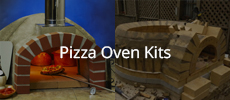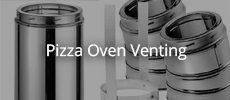Cheers Mike, yeah I'm pretty stoked with the end product, everyone says it looks awesome.
Cranked up the heat last night for our first pizza cook, very nervous but was all for nothing. Those bricks just soaked it up.
The pizza was thumbs up, the crust was everything I was expecting. Need to work on our dough shaping skills thou.
I made 2 batches of dough so we could compare the flour, Wallaby brand and 5 Stagioni, an Italian 00 flour. The latter was definitely superior. Softer and lighter in texture.
Now I need a door. I've considered steel with an insulation sandwich but I'm not convinced it would work as well as wood so a wooden door it will be. 2 layers of 30mm ironbark, 60mm total. It's a dense timber with a very good fire rating, it might be a tad heavy thou.
Announcement
Collapse
No announcement yet.
Build started in Mountain Top NSW
Collapse
X
-
Your build turned out pretty awesome Gretsch! I honestly think that dome builds are like concrete pours when it comes to cracks...every one has some, but not everyone will admit it. Some are bigger than others but the overall construct is still extremely solid and functional. As noted before, with some "antique" builds, the bakers actually use the crack movement/increase to judge the oven's heat storage and readiness to bake. Fancy IR guns are great, but 100 years (or more ago) the toss of flour on the cooking floor and other visual/physical cues were all that the bakers had to go on.
Glad that the curing process is going well...soon you'll be faced with new issues like "How can I make this fabulous pizza better...?" I think you've definitely earned that adult beverage with your first WFO dinner!
- Likes 1
Leave a comment:
-
Day 4 came and went, pretty much same olí burnt for 9 hrs total, started spreading the hot glowing charcoal out towards the edges to distribute the heat out and under the floor to aid in dispelling the water that must be trapped there. Dome top temp peaked around 350, sides starting to ramp up to around 200 and 160 on the first rows of bricks.
Day 5 now and starting to use up more timber. Ceiling peaked 500 before I intervened and spread the burning logs out. Sides are around 350 the bottom row 250.
No sign of cracking so far What I noticed is the brick joints are standing out against the blackened faces, either the creosote is burning off there or Iím looking at brick expansion.
What I noticed is the brick joints are standing out against the blackened faces, either the creosote is burning off there or Iím looking at brick expansion.
The past week or so has been 30+ which is helping the moisture dissipate, having hit some high readings Iím feeling confident to crank it right up tomorrow.
Thanks to SableSprings comment regarding the chamber depth the stack seems to be doing a good job drawing the smoke out and up, there's lots of creosote on the inner part but hardly anything comes out the front. Very happy chappy.
Leave a comment:
-
Day 1 started the fire at 11am, was a bit nervous, got hot at times so had to monitor the fire regularly. Was listening for the dreaded crack and it didn't happen. Wood was hard to get going and keep going so had to regularly stoke and re-light through the day, I read somewhere on this forum it's the moisture coming out which is the cause.
5pm I did something really stupid. I moved the fire across to the other side, too close to the wall and thought it would burn down and go out, and walked off. Obviously it flared up and I've cracked 3 bricks (see picture below). Sorry UtahBeehiver, I read your post too late. OK, so deep down I really wanted to be part of that exclusive club so I can say I've cracked it. (sic)
OK, so deep down I really wanted to be part of that exclusive club so I can say I've cracked it. (sic) 
Day 2 started the fire 7.30 am, noticed it started easier and wasn't going out as often, kept the fire burning until around 4 pm, at least it was uneventful. It's relatively hard to tame down the fire without it getting too hot, I've had readings off the dome top of 300c and am amazed nothing else has cracked.
Day 3 of firing, continually monitoring and knocking down the fire when it runs away. This morning I noticed some fine lines along the dome top brick edges, could be the dome expanded and has opened up slightly, not sure without sticking my head in for a closer look.
I can feel the bottom of the slab getting warm which is a worry considering I used those light weight kiln insulation bricks on their side (110mm height) but I'm hoping it's the water that's probably sitting in them that's causing the heat to be conducted to the slab, only time will tell.
I didn't put in any vent for the water to escape because I figured (1) Didn't use much water in the insulation layer (2) outer shell is of pressed bricks, they pass water very readily (3) any steam pressure will find it's way out at the heat break, there's a 20mm dia fire rope in the gap. (4) the floor is standard fire bricks so I reckon any water under there should easily leech out between the gaps.
Here's the final specs on the oven dimensions:
Internal dia: 1065mm
Overall external dia: 1770mm
Fire bricks are 110mm and external house bricks were cut down to 85mm which leaves a cavity gap of around 150mm which has 2 layers of blanket and mostly dry filled perlite with some mixed with cement mainly around the very bottom and the top where it was easier to lay, and it supported the house bricks.
Internal arch opening: 495 x 323mm
Internal height: 510mm
And so it worked out I managed to achieve my 63% dome height to opening height 2 Photos
2 Photos
Leave a comment:
-
Congrats. Take it slow and easy firing. This is the point where builders get impatient and fire too hot too quickly. Take your time, nice work.
- Likes 1
Leave a comment:
-
Job done! Looks a million bucks (but that's my opinion only)
Fired it up today, chimney was finished yesterday, so far so good. After an hour or 2 I noticed a couple of bricks have parted slightly on the inner arch, looks like the glue let go and the arch expanded out. I'm not too worried thou.
So it's been sitting idle for at least 2 months while on holidays and building the outer shell so the internal dome must be fairly dry but not completely, because I found some moisture on the wooden door that I put on it for a few days.
The temp reading is between 60 and 200C depending where I aim the thermometer so don't really know which reading is valid for the startup days. Any opinions on this ?2 Photos
Leave a comment:
-
Well ended up doing what I said, building the outer shell up and filling it with dry perlite. I figured no cement in the mix would lead to better insulation and secondly I get impatient at times and my method eliminates a job and I'll be cooking pizza faster
This worked well on the vertical sides and as the curvature increased I was able to then revert to cement mix for the rest. I'm getting near the end, looks good from the photos posted here but don't look too close. The outer dome ended up not so round with a hump in one place and a crooked line of bricks on one side where the dome meets the barrel. Still, I'm confident it's not going to collapse, I'm the kind of bloke that will produce something that will last, but may not be pretty.2 Photos
Leave a comment:
-
Take a handful of the mix and press it against the blanket for about 2 secs about 35 mm thick, making a flat top that you can form the next layer onto. I also find a mixture of vermiculite and perlite, half and half, makes a more workable mix than either of them alone. Adding more cement makes it more workable and increases its strength, but drastically reduces its insulating capacity. Once done you can tap the surface lightly with the flat of a trowel to get a perfectly spherical form by eye.Originally posted by Gretsch View Post
Hey thanks Steady and also UtahBeehiver
Im up to the vermicrete layer over the calsil blanket part. Ive got chicken wire in place and using the 10 to 1 mix and itís not wanting to stick to the sides, itís crumbling away. Tried 8 to 1 mix not much better.
Think Iíll try david cís suggestion of a handful of powdered clay from my brick cuttings in the mix and see how it stands up.
Make sure you wear gloves.Last edited by david s; 01-12-2018, 04:37 AM.
Leave a comment:
-
Yeah thats a thought that I had as well and started to do that but its not stacking well either and itll be a slow and long wait between courses...Originally posted by Gulf View PostForget trying to "stick it to the sides". Lay it from the bottom up, one course at a time. About 6" in height. By the time you get all the way around, the last course will be stiff enough to handle another.
BTW thats a nice looking dome you got there, is that concrete around the base ? Maybe to keep back the water seeping in ?
Another point is Ive used up a bag of cement to 1 1/2 bags of perlite! Thats a lot of cement!
So a change of tactics is needed and what I think Ill do is start laying down the brick shell and as it rises just pour in the dry perlite. Same idea as if it were a dog box. When I get to the curves Ill revert to the cement mix so I can lay the bricks back against the set perlicrete.
Now Ive seen UtahBeehiver (for one) has put a vent cap on the top of his dome to allow any moisture to escape. That looks like a good idea to me, might have to steal another idea from this fabulous forum
Leave a comment:
-
Forget trying to "stick it to the sides". Lay it from the bottom up, one course at a time. About 6" in height. By the time you get all the way around, the last course will be stiff enough to handle another.1 Photo
Leave a comment:
-
Hey thanks Steady and also UtahBeehiverOriginally posted by Steady View Post
As you should be, its very neat and looks great
Im up to the vermicrete layer over the calsil blanket part. Ive got chicken wire in place and using the 10 to 1 mix and itís not wanting to stick to the sides, itís crumbling away. Tried 8 to 1 mix not much better.
Think Iíll try david cís suggestion of a handful of powdered clay from my brick cuttings in the mix and see how it stands up.
Leave a comment:
-
Thanks for the compliment, I got it from Claypave near Ipswitch, it's called Rylbond mortar, an air set product.Originally posted by shanesmith80 View PostVery neat job on the vent.
Where did you get the refractory glue?
If you're around the Sydney area these places both sell something similar:
http://www.fieldfurnace.com.au/high-...uldables-c-14/
- Likes 1
Leave a comment:







Leave a comment: